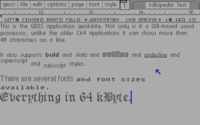GEOS (8-bit operating system)
From Wikipedia, the free encyclopedia
 GEOS for the Commodore 64. Mimicking Commodore's OS core naming/misspelling, Berkeley called GEOS' core a "kernal" (cf. kernel). |
|
| Company / developer | Berkeley Softworks (later GeoWorks) |
|---|---|
| Initial release | 1986 |
| Available language(s) | English |
| Supported platforms | Commodore 64, Commodore 128, Commodore Plus/4, Apple II family |
| Default user interface | Graphical user interface |
GEOS (Graphic Environment Operating System) was an operating system from Berkeley Softworks (later GeoWorks). Originally designed for the Commodore 64 and released in 1986, it provided a graphical user interface for this popular 8-bit computer.
GEOS closely resembled early versions of Mac OS and included a graphical word processor (geoWrite) and paint program (geoPaint). For many years, Commodore bundled GEOS with its redesigned and cost reduced C64, the C64C. At its peak, GEOS was the third most popular operating system in the world in terms of units shipped, trailing only MS-DOS and Mac OS.
Other GEOS-compatible software packages were available from Berkeley Softworks or from third parties, including a reasonably sophisticated desktop publishing application called geoPublish and a spreadsheet called geoCalc. While geoPublish was not as sophisticated as Aldus Pagemaker and geoCalc not as sophisticated as Microsoft Excel, the packages provided reasonable functionality, and Berkeley Softworks founder Brian Dougherty claimed the company ran its business using its own software on Commodore 8-bit computers for several years.
Enhanced versions of GEOS later became available for the Commodore 128 and the Apple II family. A lesser-known version was also briefly released for the Commodore Plus/4.
Written by a group of programmers, led by Dougherty, who cut their teeth on limited-resource video game machines such as the Atari 2600, GEOS was revered for what it could accomplish on machines with 64–128 kB of RAM memory and 1–2 MHz of 8-bit processing power.
Unlike many pieces of proprietary software for the C64 and C128, GEOS took full advantage of many of the add-ons and improvements available for these systems. Commodore's 1351 mouse was supported by GEOS, as were its various RAM expansion units. GEOS 128 also fully supported the C128's 640×200 high-resolution VDC display mode through a compatible RGB monitor.
The C64 version of GEOS incorporated a built-in fast loader, called diskTurbo, that significantly increased the speed of drive access on the slow 1541. (GEOS 128 could take advantage of the C128's enhanced "burst mode" in conjunction with the 1571 and 1581 drives.)
Via Berkeley's special geoCable interface converter or other third-party interfaces to connect standard RS-232 or Centronics printers to the Commodore serial bus, GEOS supported a wide variety of printers, including HP PCL printers and the Apple LaserWriter. This ability to print to high-end printers was a major factor in making GEOS a desktop publishing platform.
The Apple II version of GEOS was released as freeware in August 2003. The Commodore 64/128 versions followed in February 2004.
Revivals were seen in the HP OmniGo handhelds, Brother GeoBook line of laptop-appliances, and the New Deal Office package for PCs. Related code found its way to earlier 'Zoomer' PDAs, creating an unclear lineage to Palm, Inc.'s later work. Nokia used GEOS as a base operating system for their Nokia Communicator series, before switching to EPOC (Symbian).
[edit] GEOS products and applications
Dozens of official and third-party applications and other products were produced for GEOS. Among the most important and popular were the following:
- geoBASIC
- geoCable
- geoCalc
- geoChart
- geoDex
- geoDraw
- geoFAX
- geoFile
- geoFont
- geoLabel
- geoPaint
- geoPrint
- geoProgrammer
- geoPublish
- geoSpell
- geoWrite
- geoWrite Workshop
[edit] References
- Farr, Michael (1987). The Official GEOS Programmer's Reference Guide. For Commodore 64/64C/128. Includes versions 1.0, 1.1, and 1.2. Bantam Books/Berkeley Softworks. ISBN 0-553-34404-8.
- Tornsdorf, Manfred; Kerkoh, Rüdiger (1986). GEOS Inside and Out. An introduction to GEOS, its applications and internals. Abacus/Data Becker. ISBN 0-916439-81-X.
[edit] External links
- The Commodore GEOS FAQ v1.4.2 – By Bo Zimmermann
- Full Commodore GEOS download (not for redistribution or sale) – At the website cbmfiles.com - Courtesy of Click Here Software Co.
- GEOS: The Graphical Operating System A lengthy review of GEOS and its history
- geosDS – Run GEOS for Commodore 64 on your Nintendo DS



